“In my view, the surfing in the Mentawais is the key to open the padlock. The Mentawais are isolated islands and surfing is the key to make the Mentawai people see outside. And other people see in.”
— Eka Darman, Padang-born boat driver
From the bow of the Midas you can sight straight down the throat of the Mentawai’s marquee wave, Lance’s Right. Today it’s small by Mentawai standards, but even at a relatively playful four feet, Lance’s throws out a thick, full-body barrel.
This afternoon there are five charter boats, including Midas, anchored out at Lance’s. An international crowd of 22 surfers — Aussie, Brazilians, Japanese and Americans — jostle around the tight takeoff zone known as “The Office.” Conan Hayes picks off one from the outside and disappears for the length of the wave. He pops out far inside and glides into the flats with a shy but stoked gap-toothed grin.
The curio sellers, local woodcarvers from the nearby village of Katiet, dog the boats like pilot fish as each boat crew rotates in and out of the lineup. The bottoms of their slender dugouts are lined with an array of hand-carved art that runs the gamut from indigenous handicraft to cut-rate kitsch. This late in the season they knew that most boats would not be returning until March. They were blowing out excess stock at bargain rates. The going price for a trinket box was two dollars, or a decent surf-logo t-shirt.
This is the spontaneous ecology of tourist commerce created by the Mentawai surfer trade. Lance’s Legacy. I’d seen similar surf symbiosis develop over the years between locals and gringo-god surfers at the campground fronting San Miguel’s.
When Aussie surfer Lance Knight first surfed this shallow, near-flawless barrel in 1991, he had no concept that he was the pioneer scout of a global ant trail that would eventually support a multi-million-dollar international charter industry. Or spawn a thriving indigenous surf culture from a small Third World village hidden behind the wall of copra palms.
Sonny Miller, surf cinematographer and veteran of more than a dozen Mentawai trips, is on the debut Wave of Compassion trip this year. He’s been able to track the epidemiology of introduced surf fever on an annual basis.
“The thing I’ve seen over the years is the rapid evolution,” says Miller, who first filmed Tom Curren at Lance’s Right in 1992 for The Search aboard the original Indies Trader. “For years it was just a crew of little kids out on the point watching the surfers. But then you came back one year and they’re out there bellyboarding little inside waves on raw wooden planks. Then a year later you see them standing up on broken boards they’ve fixed up. This year I saw a couple teenagers going out to the main peak here at Lance’s Right on small days. That’s after only five years. Who knows, in ten years the world champ may be from the village here.”
The inaugural Wave of Compassion (WOC) event is essentially a 10-day media trip but with a significant twist. First, the funds generated by raffling off two slots on the trip will go to SurfAid International to help fight malaria and improve the health of the Mentawai islanders. Second, for most of the surfers and media involved, it will be their first time ashore to meet the locals.
“Our surf culture has thrived off the Mentawai Islands for ten years now,” says Strider Wasilewski, another WOC invitee. “It’s also created a culture here that the people are now thriving on. So in a sense we (as surfers) need to help them take care of themselves because we’re part of the reason they’re here. It’s a chance to give back because we’ve been sucking the nipple pretty dry.”
We are aboard Midas, a 74-foot luxury motor yacht flagged out of Singapore. The Midas sports a living-room-size salon, four ensuite cabins, one skipper, two cooks, four crew, two massive diesel engines and a sustained cruising speed of 20 knots. At night we steam through these torpid equatorial seas sipping tea and watching Gladiator in Dolby Surround Sound.
By a week into the trip we’ve scored steady but by no means epic surf. But a trip this late in the season was a gamble to begin with. We’ve been grateful with what we got so far. We started in the north and gradually ticked off the list south: Kandui’s, Bank Vaults, Pit Stops, Four Bobs, Lance’s Left, Lance’s Rights, Bintangs, Scarecrows, Macaronis, and Thunders. Each morning we awake to a new spot. The vibe thus far has been relaxed and professional, full of war stories, surf gossip and good-humored character assassination.
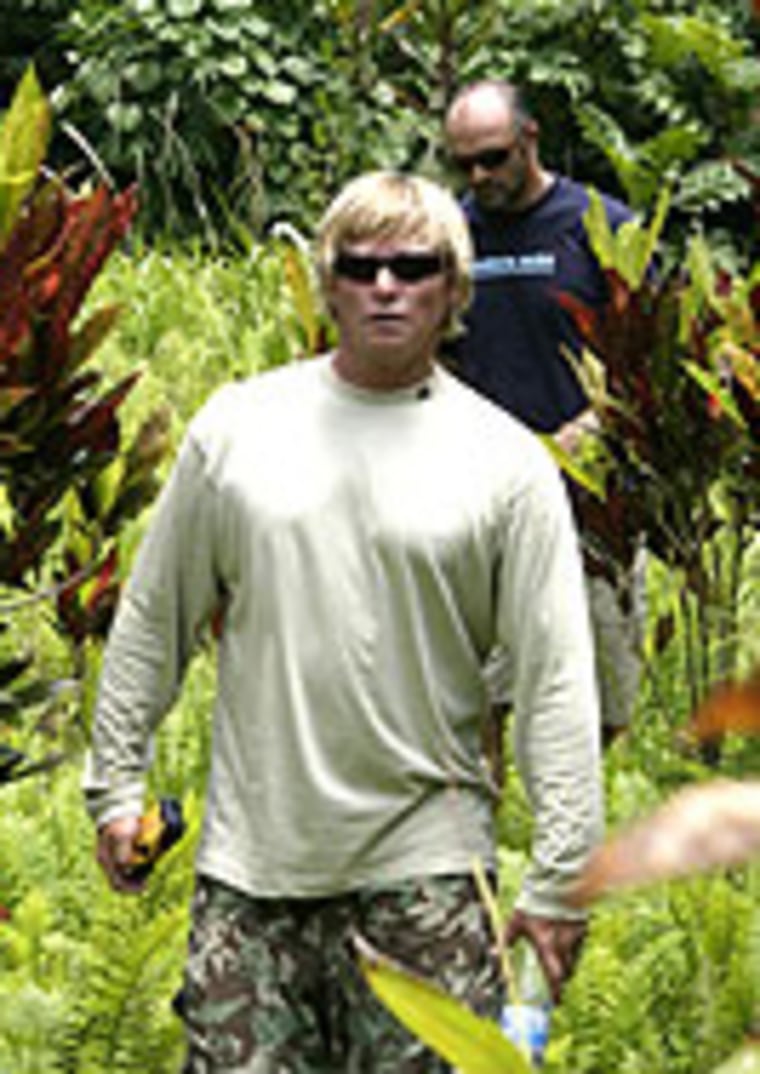
“I can’t remember laughing so hard in my life,” says the Wave of Compassion winner Jack Bunnell. Besides Conan and Strider, the WOC lineup included Ben Bourgeois, Dave Rastovich and Keith Malloy. The two WOC sweepstakes winners were Jack and Dani Bunnell from Kailua-Kona, Conan’s hometown. Jack is a dentist with paramedic training. Dani skippers a sightseeing submarine out of Kona. Jack surfs, Dani bodyboards. They have a four-year-old son named Kaikea who is just starting to bodyboard. Outside of a surf trip to Tavarua this year, however, this was the couple’s first time traveling outside the U.S. “We had to look up the Mentawais in an atlas,” admits Dani. “It was a heartbreaker leaving Kaikea but there was no way we were going to miss this.”
At the outset Dani says they were somewhat apprehensive about spending 10 days afloat with a tight clique of A-List pro surfers and media journeymen. After a few days, however, she realized that surf stars need to light a match in the bathroom like everybody else.
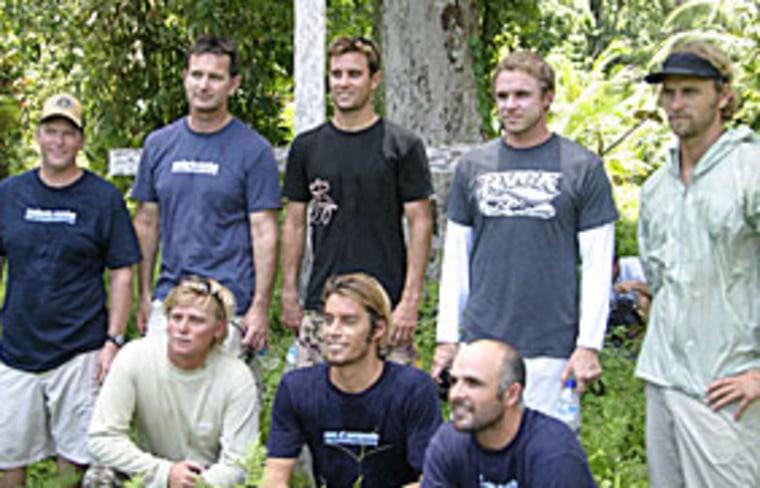
“It’s pretty cool to be a fly on the wall and get this inside view into the fantasy life of a pro surfer you only see in the mags and movies,” says Dani. “They’re real people with families, hobbies and other things going on outside of their surf gigs. Their lives may look glamorous, but it’s work. They’re on the road constantly and when it’s good they have to go out and perform whether they’re feeling up to it or not. But it’s somewhat surreal to be reading about Dave Rastovich in a surf magazine and then turn to him and go, ‘So Rasta, is this true?’”
By now the rest of the WOC surfers have joined Conan for a shift out at The Office. The dropping sun pops out of the equatorial murk for a half hour and bathes the scene in sweet golden f8 light. Our small platoon of cameramen — Justin Krumb, Jeff Divine, Sonny Miller and Scott Bass — patrol the channel in Midas’s motor launch. Each time someone takes off they swing their lenses up with marching-band precision.
The Mentawais as a surf destination are in a subtle but profound transition. After a brief but steep dip in business due to 9/11 and the 2002 Bali bombings, surf charters are back at full capacity. There are now an estimated 40 boats — most of them Padang-based — working the 100-mile Mentawai archipelago during the April-through-October surf season. Business is booming.
Under post-Suharto autonomy, however, the Mentawai people have been given a mandate to develop their own economy separate from Sumatra. Besides logging and their traditional copra and spice industries, this now includes tourism.
And more recently, land-based surf resorts. There are at least three land camps currently under construction and plans for a half-dozen more. While it doesn’t spell the end of the surf charter trade, it does point toward a more profound intertwining — for better or worse — between surfers and their Mentawai hosts.
SurfAid Chief Executive Officer Andrew Griffiths is concerned about the impact surfers have culturally and economically on native cultures. What everyone — surfers, charter operators and land-camp operators alike — wants to prevent is the creation of yet another surf ghetto ala Nias or Uluwatu.
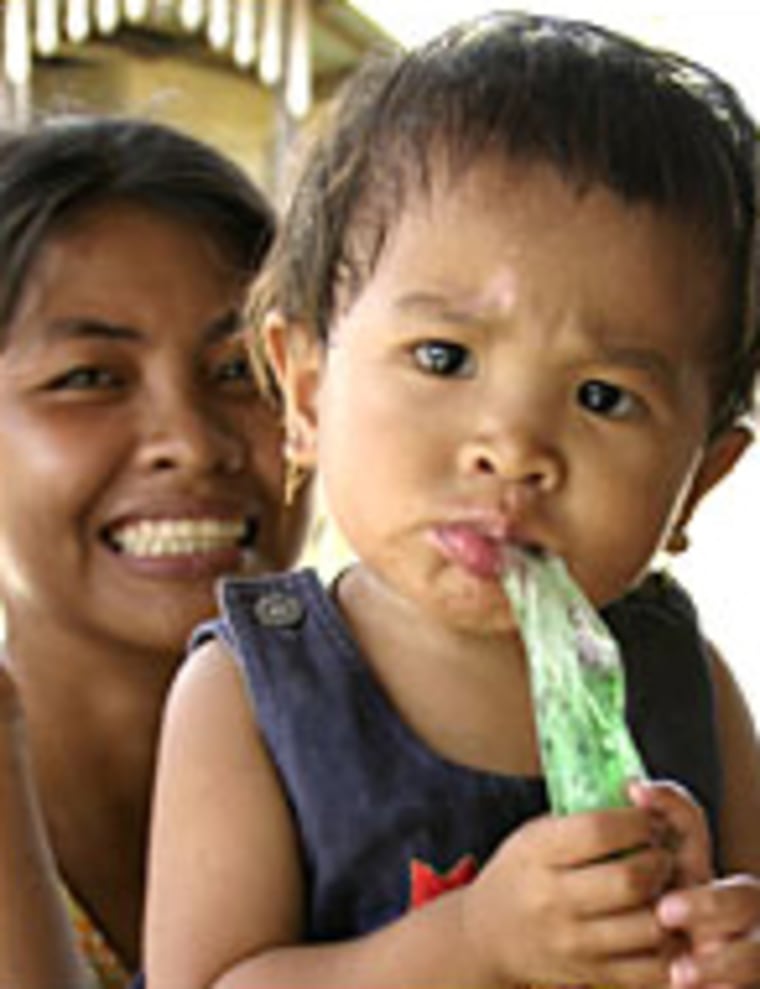
The Mentawai people, says Griffiths, are naturally friendly and curious, and are hungry to get up to speed with the modern world they get piped into them via satellite dish TV. However, this steep cultural learning curve could lead to ill-planned, unsustainable growth. “You can't rely on regulations here,” says Griffiths. “If we do help to reduce malaria here to a point where it's safe to visit and surf these islands, I would hate to see it go the way of the Nias surf-slum model.”
Griffiths recalls visiting Katiet, the village that fronts Lance's Rights, a few years back. A small village kid, perhaps six or seven years old, ran up to him and chirped in a high gleeful voice: “**** you, mate!”
“That kid had been taught to say that by some brain-dead surfer off a boat looking for a laugh. What that surfer didn't realize is that if you treat people like that it won't be long before they mean it.”
Griffiths points to the Maldives as a sustainable tourist model for surfing. Of 200 Maldive atolls, 84 have been developed for tourism under strict guidelines.
“Each resort has been designed with the local culture and carrying capacity in mind so that the local people benefit from high-end tourism but aren't flattened by it,” says Griffiths. “As we move forward here in the Mentawais we have to talk about what's real versus what sells tourist t-shirts. And what's real — like clean water, good nutrition and adequate health care — costs money. Face it: The surf frontier is closed. Spots like Lance’s must be managed or we lose them to overdevelopment.
“There's no way back but there's a right way forward.”
Sunny Sunday afternoon puttering upriver, passing fishing boats and huge lemon-colored butterflies. Squawk of parrots, distant howl of monkey. Thatch-roofed wooden shacks; kids, pigs, goats, drying laundry. Glittering CDs hang from eaves for décor. The banks of the Siberut River are thick with verdant lowland forests, their upper canopies strangled by thick beards of morning-glory creepers. Across our bow a large monitor lizard cruises by, its cruel serpentine head held erect as a periscope. We are a convoy of three large canoes, 15 people in all, loaded to the gunnels with backpacks, camera gear and an arsenal of military-strength mosquito repellents. As part of the Wave of Compassion we are to spend a night in a traditional Mentawai longhouse, called an uma, as guests of an upriver clan. Spirits are high as we embarked on the proverbial three-hour cruise.
Along the way we played a game of spotting perfect boat-wake barrels spinning off at the bend shallows. We passed smiling villagers in sliver-thin canoes laden with rattan, chickens, sago and coconuts. On the distant misty bank I could see the occasional impromptu logging camp, a red bleeding scar of wounded raw earth leading to the water's edge.
After an hour’s travel up the winding tortuous river we pulled up to a small cutout in the embankment. A large contingent of villagers and flower-bedizened Sikerei were waving from the bank.
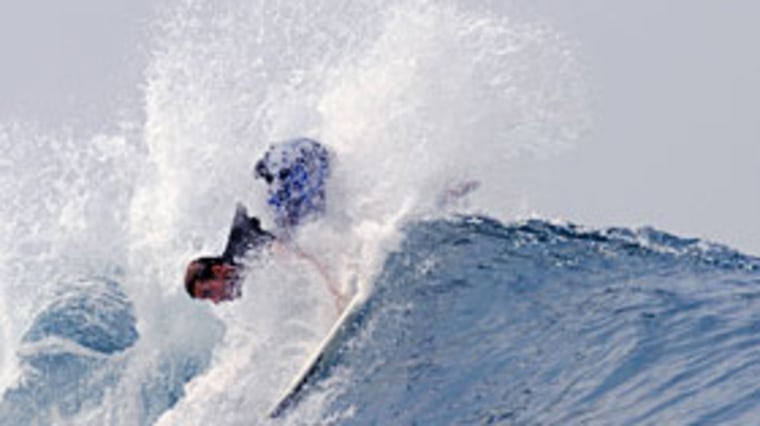
We greeted our hosts. The shamans, four small muscular men ranging between 40 and 60, were decked out in full ceremonial garb: beads, bells, red hibiscus blossoms and the occasional Timex with frozen hands. Each puffed away merrily on a large smoldering tobacco spliff. They shook hands lightly, their dark bemused eyes sparkling at the sight of our sweaty pale huffing selves struggling up the riverbank. To each of us they said softly “aloeta,” the Mentawai “aloha.”
“These guys were like the jungle equivalent of an NYC rap star,” recalls Strider. “They were buffed and cut, pimping this sick tribal stuff with these amazing tattoos that covered their whole bodies.”
The villagers immediately grabbed our gear and started trucking up into the jungle. We were each given a walking staff made from a freshly cut bamboo pole. We clung to them desperately once we started down the trail; little more than a narrow sluice of shoe-sucking mud cut through the dense jungle foliage.
“The surfers were definitely out of their comfort zone,” laughs Dr. Dave Jenkins, who has spent countless hours in upriver villages running makeshift health clinics. “There was a level of apprehension and some very real dangers out there. It was pretty amusing watching these guys who are such great athletes blurping around in knee-deep mud and falling on their asses.”
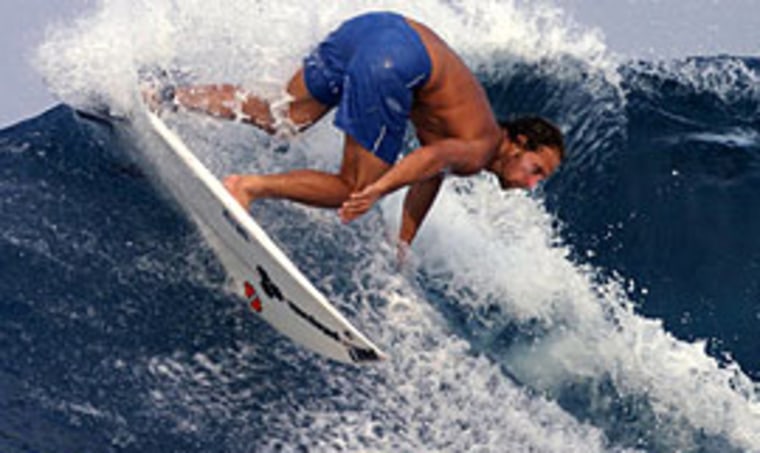
After a half-hour’s hike we came upon a large thatched uma nestled next to a small stream. A small stockade of caged pigs grunted their greetings. Small kids giggled and nudged each other from the doorway.
The Sikerei took us down to the stream and showed us how they make loincloths by beating the inner bark of a certain small tree. Keith jumped in and was soon pounding away alongside the medicine men. Where we saw an impenetrable hostile jungle the shamans saw a garden, shelter, hardware, clothing and pharmacy.
There is no distinguishing the Mentawai from their forest. They are as much a part of it as if they were to sprout roots from their feet. The Mentawai creation legend tells of a sky that rained pigs and the child who turned himself into a sago palm so that that the Original People, The Mentawai, would never go hungry.
“It was like time had stopped for these people,” observed Conan, who relished the opportunity to indulge his passion for portrait photography. “You may see these kind of medicine men on National Geographic but you’re never up close and personal with them like that. They’re characters. They have a lot of personality. Even though we can’t speak each other’s language you do communicate. They were really interested in my tattoos and what they meant.”
The Mentawai forest people are an anthropologist's dream thesis: a remnant tribe of neolithic forest dwellers who somehow survived into the 21st century free of the cultural ravages inflicted by successive regimes of colonialism. Far from primitive, they enjoy a highly evolved clan structure tightly geared to auspicious earth cycles.
“Mentawaians try to live in a way that is pleasing to the soul and keeps it near at hand,” writes Benedict Allen in his “Last of the Medicine Men.” "Out of consideration for their souls they avoid all rushing around. ‘Moile, moile,’ ‘slowly, slowly.’ In very general terms, a peaceful, harmonious, not-too-stressful existence corresponds to the desire of the soul.”
To a Mentawai Sikerei it's all about keeping cool in the sweltering jungle. The fever means the things are out of balance, the spirits are displeased. A malevolent spirit will heat up a body, making it sick and feverish. Sweet flowers, shade and healing herbs cool off the body, makes it pleasing to the soul. Through song and rituals the Sikerei brings balance back into the real and metaphysical worlds.
The elders observe to Dr. Dave that there’s much fever in the logging camps. Dave says that this is not surprising. Disease usually rises in disturbed natural environments. In the case of the logging camps, deforestation creates swamps that creates prime mosquito-breeding habitat. Without the natural predators provided by the forest, they breed unchecked. The malaria parasite spreads rapidly.
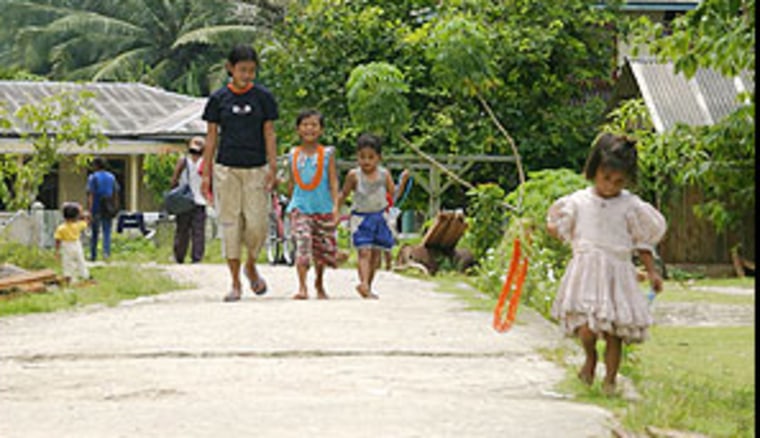
In 1980, a coalition of wildlife and environmental groups was able to convince the Suharto regime that it would be in the best interest of Indonesia and the world not to clearcut Siberut for hardwoods. Despite massive lobbying from the timber companies, almost half the island, which measures approximately 60 miles by 40, was declared a world heritage "biosphere"; its unique plants, animals and people to be guarded in perpetuity by, presumably, the world. Since then, however, the logging companies have been slowly but inexorably chewing into the reserve's porous borders. Of the 160 million hectares of Siberut rainforest originally set aside, only 92 million remain. Under Indonesia's fledgling democracy, the Mentawais must develop their own economy or face being ruled by fiat from Jakarta. Hardwoods are vastly more profitable than any other resource, and when cleared they can be replanted with coco palms for copra plantations.
If logging is left unchecked, however, this gentle culture, with its irreplaceable lessons and secret plant cures, could be mowed down within a generation to provide a luxury yacht such as ours with decorative trim.
The interior of the uma was dark and smoke-stained from generations of open cookfires. The skulls of pigs and monkeys hung grinning from the beams, honoring the animals so that the uma would be blessed with their spirits and meat.
Around sunset one of the Sikerei trucked in a struggling pig on his back. It was bound with a single twisted palm frond. We watched in hushed stunned silence as the pig was prepared for sacrifice. The shaman assured the pig that although its body was required to honor the uma’s guests, its spirit would be well taken care of. The pig didn’t seem convinced.
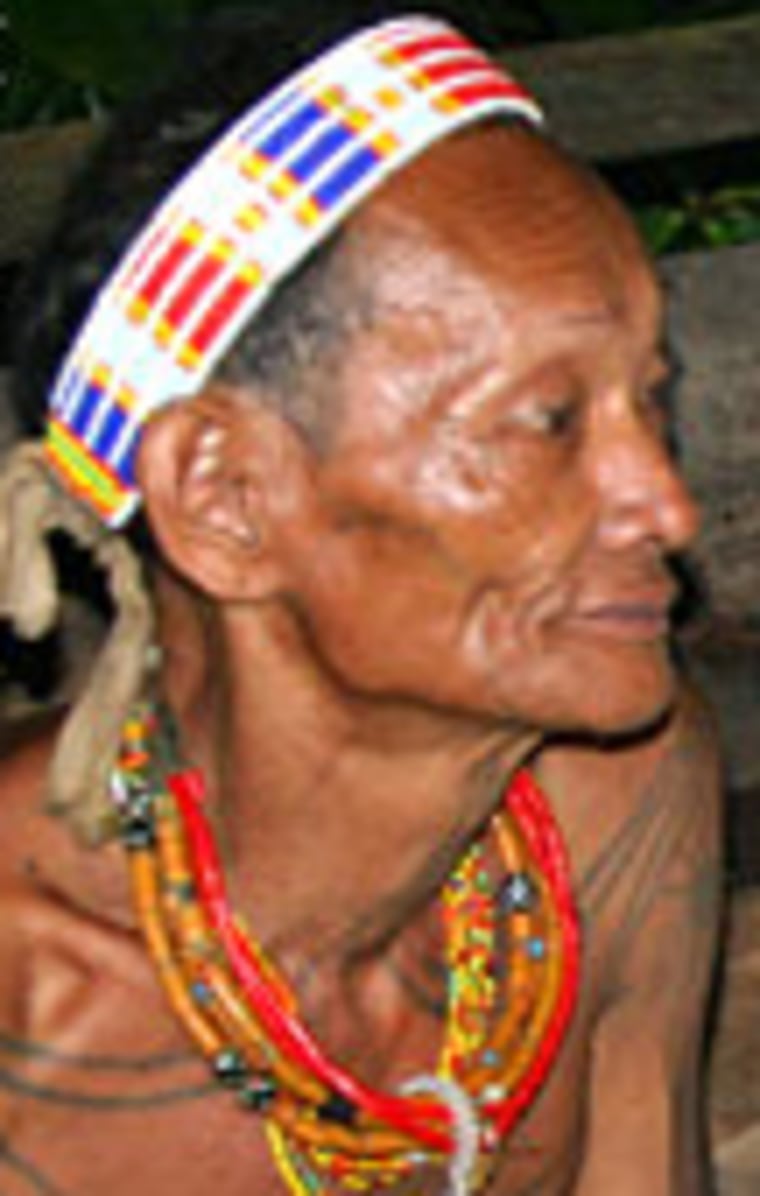
The pig was efficiently dispatched with a large knife to its jugular and bled into a large wok. Within minutes the shamans eviscerated the pig and its still-pulsing heart was examined closely for portentous omens.
That evening, as the cooked pig was being divvied up and stored in fresh bamboo, the Sikerei began a long low singing chant. At first no one paid much attention except us; women gossiping, kids giggling, babies crying. By the middle of the second song cycle, however, everyone had quieted down and synched into the shaman’s vibe.
Shortly after midnight the shamans performed their sacred circular dances. Each dance — the Bird Dance, the Monkey Dance, the Chicken Dance — was a slight variation on a common shuffling step performed with nothing more than a cowbell, a small snakeskin drum and their bare feet stamping out a lively beat on the rattling wood floors. With each dance the shaman would channel the persona of the animal to honor its spirit.
We applauded and let out big surfer hoots.
As a gift for the uma, Rasta played his Swiss-made “hang” drum that he carries with him everywhere. The hang resembles two woks welded together and by tapping lightly on the drum, Dave produced beautiful doubled beats that slid effortlessly across a tuned harmonic scale. The clan crowded round and laughed excitedly. They instinctively understood the power of a sacred drum.
“It was amazing…we had thunder and lighting and the whirring of all the insects all around us,” recalled Rastovich, who’d meticulously recorded the Sikerei chants. “You could hear pigs rooting under the house, chickens cackling in the trees. The smells were so organic — rich and thick. It put me in another realm. We could have shot that same scene a couple thousand years ago. Timeless, really.”
“SurfAid, the fledgling surfer-run NGO, is lurching down a short runway, suffering from chronic underfunding and burnout. The situation is past dire. It’s ludicrous. They could likely be gone by the end of the year. But they just might pull it off. And in trying to save the world, or at least a small part of it, they just might salvage surfing's lost soul.” —Author’s log note, enroute to Padang via ferry, Mentawai Straits, June 15, 2002.
Back on Midas, shortly before sunset, I watched Julian ferry Conan back from surfing to the little reef break with the Katiet grommets. We’ve been to Lance’s three times now, and each time seen a small crew of young village kids surfing a short shallow inside break just south of us. They rode a collection of crudely patched boards with a gawky no-fear style and their little asses falling out of threadbare boardshorts.
“That was so fun,” says Conan as he stepped dripping onto the fantail. “I started yelling go-go-go! to this one little grom and pretty soon everybody was yelling: ‘go-go-go!’ Those kids are so stoked!”
Up topsides, I resume my interview with Dr. Dave Jenkins. He is looking relaxed and fit after a day out surfing with a crew of SurfAid supporters aboard Martin Daly’s Indies Trader III.
The last time we talked like this was over two years ago in a rudimentary beach camp near E-Bay where Dave and a small crew of doctors and volunteers had pitched up after a day treating and distributing mosquito nets to the Taileleu villagers. Back then, Dave was still running MASH-style malaria clinics upriver by long canoe. It was a pretty seat-of-the-pants operation. Dave and crew would show up for the day, hand out mosquito nets and various vaccinations, then push off and hope for the best.
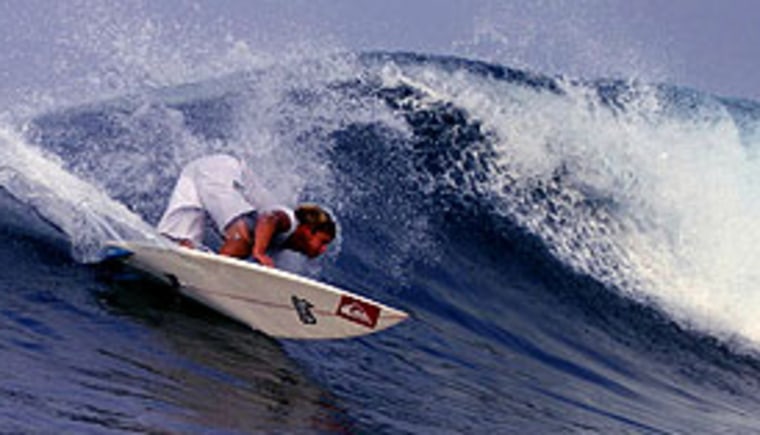
Two years ago, Dave and his small crew were fighting for their financial survival. The surf industry had yet to get the message, many refused to even listen. Key personnel hadn’t been paid in months and were dropping out. Dave even took a day job as a ski-resort medic in New Zealand for a few months to patch things over to the next season.
“We were weeks away from locking up the office,” admits Dave.
However, Dave and a core group hung on. Early in 2003, SurfAid USA was established to lobby the U.S. surf industry. Some key contacts were made.
Thanks to Santiago and Fernando Aguerre of Reef, Dave and Andrew were introduced formally to the surf industry at the 2003 SIMA conference. Something struck home. After a short video presentation, Dave received a standing ovation.
“That was the turning point,” recalls Dave. “Things got real hectic after that.”
With a bump in funding, SurfAid’s momentum increased markedly.
As SurfAid’s chief medical director and spokesman, Dave has been logging more frequent-flyer miles than a WCT pro. He spends months on the global road shuttling between the U.S., Australia, New Zealand and Indonesia hustling up support from government health officials and surfwear barons. He reports to an international board of directors who bring a wealth of professionalism from private sector, enabling SurfAid to gain critical legitimacy as an effective world-class aid organization.
Back in the islands Dave’s just hired 30 new Indonesian health facilitators to help Mentawai locals break the malaria cycle. Donations are at record levels due to private donors and ramped-up surf industry support. In partnership with the surf industry, companies such as Quiksilver, Billabong, Hurley and FUEL TV have helped to fund SurfAid’s health campaign through the Adopt-A-Village program.
The numbers: to date, Surf Aid has given more than 20,000 immunizations in some of the most inhospitable terrain in the tropics. As a result, thousands of immunized children will not suffer from tetanus, whooping cough, measles, diphtheria, polio, and tuberculosis. In the SurfAid pilot villages there has been a 75% reduction in malaria-related death and suffering.
“In 2005 we really start hitting the straps,” says Dave. “We’ll be expanding our health program from two to seventeen villages along the length of the Mentawai chain.” Dave is fanatical about Mentawai communities taking ownership of their own health programs. Under a “micro-credit” system, SurfAid will be distributing 10,000 new mosquito nets paid for by the villagers. “That is the only way these programs will be sustainable. We can’t be running them in the long run. My mantra: ‘A hand up, not a hand out.’”
Home base is still Padang for the time being, although SurfAid has recently established a branch office in Encinitas, California in order to be close to the vital surf-industry pulse.
“The Wave of Compassion is an idea we hoped would happen for three years now,” says Dave, allowing himself a smile and a sip of beer. “And now it has. This is an incredible opportunity for the surfing tribe to say ‘thank you’ for providing such an amazing wave region. And subconsciously understand that perhaps the secret to our future somehow lies in some of these ancient cultures.
“Our joy is to link our passion to explore new breaks and different cultures with something positive. Why not let surfing be the best thing that ever happened to these islands?”
Thanks to Billabong, RVCA, Quiksilver, Patagonia, Reef, FUEL TV, SURFER Magazine and the SurfAid team for their support. Special thanks to Anthony Marcotti of Saraina Koat Mentawai surf charters (www.mentawaiislands.com) for first-cabin travel arrangements. Kudos to Captain John Bowden for his skill, patience and nose for good surf. And finally, a big terima kasih to the crew of Midas — Kasta, Sri, Eka, Mebry, Julian and Ajoe — for spoiling us rotten.
MENTAWAI SHAMAN INITIATION CHANT
Aptly you adorn the head of my friend, leoi,
My friend, the kerei, the new kerei,
Equal are his steps in dancing,
Rhythmically he stamps on the boards,
leoi.